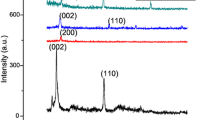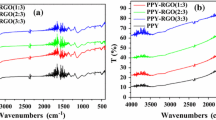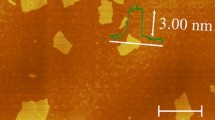Abstract
Polyrotaxane, owing to the special topological interlocked structure, has attracted more and more attention from researchers. In this paper, a new polyrotaxane derivative has been synthesized based on the polyrotaxane end capped by 2, 4-dinitrofluorobenzene (DNFB). And through cross-linking the polyrotaxane derivative meanwhile adding graphene filler, high dielectric constant elastomeric nanocomposite is fabricated according to percolation theory. SEM images show that the addition of polyvinylpyrrolidone (PVP) improves the dispersibility of graphene in the cross-linked matrix. The percolation threshold of composite with PVP-modified graphene is 2.45 vol.% and for unmodified composite it is 2.20 vol.%. Besides, the dielectric constant of composite with PVP-modified graphene increases sharply to 289.8 with graphene content of 2.35 vol.% which is 25 times higher than that of matrix. However, the dielectric loss of composite is just 0.46. What is more, the thermal stability of composites shows an obvious enhancement compared to the polymer matrix. And the composite films still exhibit great flexibility at room temperature.
















Similar content being viewed by others
References
Brochu P, Pei QB (2010) Advances in dielectric elastomers for actuators and artificial muscles. Macromol Rapid Commun 31:10–36
Carpi F, Kornbluh R, Sommer-Larsen P, Alici G (2011) Electroactive polymer actuators as artificial muscles: are they ready for bioinspired applications. Bioinspir Biomim 6:045006
Jiang L, Betts A, Kennedy D, Jerrams S (2015) The fabrication of dielectric elastomers from silicone rubber and barium titanate: employing equi-biaxial pre-stretch to achieve large deformations. J Mater Sci 50:7930–7938
Suo Z (2010) Theory of dielectric elastomers. Acta Mech Solida Sin 23:549–578
Tian M, Yan B, Yao Y, Zhang L, Nishi T, Ning N (2014) Largely improved actuation strain at low electric field of dielectric elastomer by combining disrupting hydrogen bonds with ionic conductivity. J Mater Chem C 2:8388–8397
Henann DL, Chester SA, Bertoldi K (2013) Modeling of dielectric elastomers: design of actuators and energy harvesting devices. J Mech Phys Solids 61:2047–2066
Carpi F, Frediani G, Turco S, De Rossi D (2011) Bioinspired tunable lens with muscle-like electroactive elastomers. Adv Funct Mater 21:4152–4158
Opris DM, Molberg M, Walder C, Ko YS, Fischer B, Nüesch FA (2011) New silicone composites for dielectric elastomer actuator applications in competition with acrylic foil. Adv Funct Mater 21:3531–3539
Pelrine R, Kornbluh R, Pei Q, Joseph J (2000) High-speed electrically actuated elastomers with strain greater than 100%. Science 287:836–839
Wang JW, Wang Y, Wang F, Li SQ, Xiao J, Shen QD (2009) A large enhancement in dielectric properties of poly (vinylidene fluoride) based all-organic nanocomposite. Polymer 50:679–684
Dang ZM, Nan CW, Xie D (2004) Dielectric behavior and dependence of percolation threshold on the conductivity of fillers in polymer-semiconductor composites. Appl Phys Lett 85:97–99
Li J, Loh XJ (2008) Cyclodextrin-based supramolecular architectures: syntheses, structures, and applications for drug and gene delivery. Adv Drug Deliver Rev 60:1000–1017
Mayumi K, Ito K (2010) Structure and dynamics of polyrotaxane and slide-ring materials. Polymer 51:959–967
Ito K (2010) Slide-ring materials using topological supramolecular architecture. Curr Opin Solid St M 14:28–34
Okumura Y, Ito K (2001) The polyrotaxane gel: a topological gel by figure-of-eight cross-links. Adv Mater 13:485–487
Araki J, Kataoka T, Ito K (2008) Preparation of a “sliding graft copolymer”, an organic solvent-soluble polyrotaxane containing mobile side chains, and its application for a crosslinked elastomeric supramolecular film. Soft Matter 4:245–249
Zhao C, Domon Y, Okumura Y, Okabe S, Shibayama M, Ito K (2005) Sliding mode of cyclodextrin in polyrotaxane and slide-ring gel. J Phys Condens Mat 17:S2841
Tsuchitani S, Sunahara T, Miki H (2015) Dielectric elastomer actuators using Slide-Ring Material® with increased permittivity. Smart Mater Struct 24:065030
Li YJ, Xu M, Feng JQ (2006) Dielectric behavior of a metal-polymer composite with low percolation threshold. Appl Phys Lett 89:072902
Dang ZM, Yao SH, Xu HP (2007) Effect of tensile strain on morphology and dielectric property in nanotube/polymer nanocomposites. Appl Phys Lett 90:012907
Araki J, Ito K (2006) Polyrotaxane derivatives. I. Preparation of modified polyrotaxanes with nonionic functional groups and their solubility in organic solvents. J Polym Sci Pol Chem 44:6312–6323
Wajid AS, Das S, Irin F et al (2012) Polymer-stabilized graphene dispersions at high concentrations in organic solvents for composite production. Carbon 50:526–534
Wang G, Wang J, Zhou S (2016) Enhanced dielectric properties of acrylic resin elastomer based nanocomposite with thermally reduced graphene nanosheets. RSC Adv 6:98440–98448
Dang ZM, Lin YH, Nan CW (2003) Novel ferroelectric polymer composites with high dielectric constants. Adv Mater 15:1625–1629
Acknowledgements
This work was supported by the National Natural Science Foundation of China (No. 21174063), the Natural Science Foundation of Jiangsu Province (No. BK20131358), the Aeronautical Science Foundation of China (Nos. 2011ZF52063 and 2014ZF52069), and A Project Funded by the Priority Academic Program Development of Jiangsu Higher Education Institutions (PAPD).
Author information
Authors and Affiliations
Corresponding author
Rights and permissions
About this article
Cite this article
Zhou, SW., Wang, JW., Wang, GQ. et al. Nanocomposite of polyrotaxane derivative and graphene with increased dielectric constant. Polym. Bull. 75, 289–306 (2018). https://doi.org/10.1007/s00289-017-2038-7
Received:
Revised:
Accepted:
Published:
Issue Date:
DOI: https://doi.org/10.1007/s00289-017-2038-7




